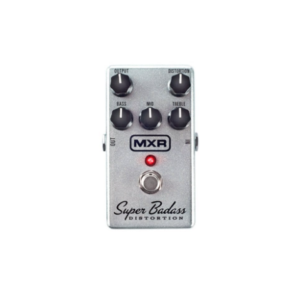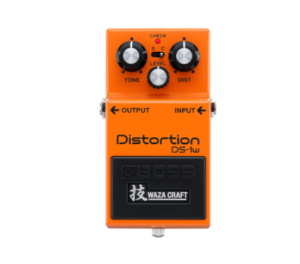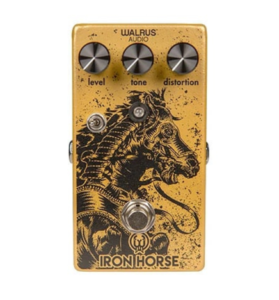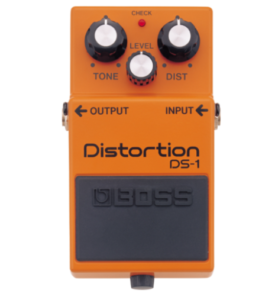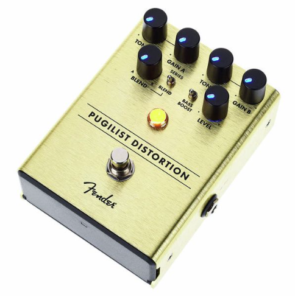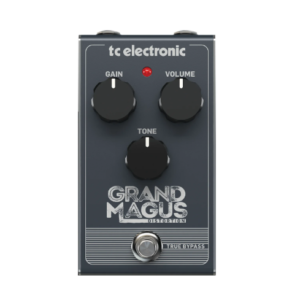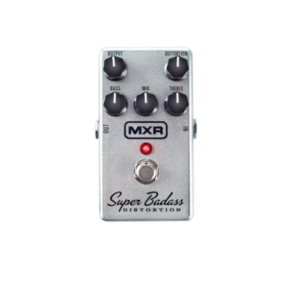Distortion pedals drive your guitar signal and add more tone than a standard overdrive. This effect has a unique tone that stands out in many music genres and is one of the most popular types of guitar pedals.
Here are some of the best distortion pedals available.
We’ve carefully selected everything from classic gain distortions to modern pedals with multiple gain stages and multiple EQ parameters to help you find the perfect pedal.
Whether you’re looking for a relatively light classic rock crunch or the heaviest metal-ripping machine, we’ve got you covered.
Best Guitar Distortion Pedals
1. MXR M75 Super Badass Distortion
For a pedal to be as bold as the Super Badass, it has to deliver some seriously jaw-dropping tones.
Luckily, this one offers enough distortion to cover most rock and metal styles, and thanks to its 3-band EQ, you can go from throaty overdrive to a more scoopy, metallic thrill, adding to its versatility.
With its impressive touch sensitivity, low noise levels, and retro silver finish, it’s a great all-rounder for just about any kind of gain-seeker.
Then you’ll be happy to know that the Metallica lead guitarist’s signature distortion pedal is a real monster. There’s also a Doom knob that can crank up the lows to seismic levels, thanks to the onboard gate.
A Hi/Lo switch lets you easily switch between rhythm and lead tones, and there’s extra treble and sustain for soloing.
Gain can be shaped via the treble control, covering an impressive range of sounds. Best of all, it’s affordable, and the black and red finish will look great on any pedalboard.
This is definitely the best distortion pedal for Metallica fans.
2. Boss HM-2 Waza Craft
The Boss HM-2 has been a popular distortion pedal for many popular guitarists over the years It’s become an industry standard, which isn’t surprising considering it was first released in the early 1980s.
HM stands for Heavy Metal, but it’s not just a high-gain pedal for Swedish death metal bands.
Of course, this pedal does a great job of high gain, which is one of the reasons it’s so popular. And that’s one of the reasons I bought this pedal.
But this pedal is much easier to use than that. It sounds amazing in low-gain settings. And some of the most famous guitarists who have used this pedal over the years include David Filmour, Johnny Marr, and Eric Clapton.
The only problem? Boss discontinued the original pedal in 1991, and used models (especially the Japanese version) are selling for ridiculously high prices.
The good news is that Boss has re-released this pedal! And as they usually do with Japanese Waza Craft pedals, they’ve expanded the pedal’s functionality a bit.
The new version has a toggle switch that gives you a custom mode that adds the classic HM-2 tone or “more.” What exactly is more? More of everything.
In custom mode, you get a tone that’s pretty similar to the standard mode, but everything is dialed up. It’s more punchy, more gainy, more aggressive.
I didn’t buy this pedal with the custom mode in mind, but after playing with it a lot, I’m glad Boss included this extra mode.
3. Pro Co RAT 2
The Pro Co RAT2 has always held a pretty special place in the hearts of guitarists. The Original RAT was released in 1978 and was an instant success.
Despite being one of the first dedicated distortion pedals, the current incarnation, the RAT2, is still one of the best.
The RAT2 has a thick, chewy sound that is incredibly rich in the low end, but still balanced enough to really punch up the highs.
It’s basically half fuzz, half distortion, and a really interesting mix of the two. If you want to know exactly what I mean, check out Blur’s excellent Song 2 made with the RAT2.
This pedal is spartan, very easy to dial in, and built like a tank. There are three control knobs: DISTORTION, FILTER, and VOLUME, plus a footswitch.
The control knobs feature rubberized grips that feel nice to the touch. The knobs adjust smoothly and have indicator lights that glow in the dark, making it easy to adjust the pedal in the dark, even while flying.
The RAT2 has rubber feet that are about 1/4 inch off the floor. This creates space for the “tool-less” thumb screw that secures the battery access door.
The 9V DC input is on top of the box between the input and output, but the power supply is not included.
4. Boss DS-1W Waza Craft
A stone-cold classic that has taken pride of place on the ‘boards’ of players like Kurt Cobain, John Frusciante, and Steve Vai.
The signature orange of the Boss DS-1W Waza Craft distortion pedal now gets a long-awaited remake thanks to Boss’s Japanese Genie.
If you’ve used a Boss pedal before, this one will feel instantly familiar when you pick it up, and it’s super easy to dial in your distorted tones.
With three controls for Tone, Level, and Distortion, it’s super easy to tweak your sound, and before we get to the mode switch, let me tell you.
There are two modes, Standard mode, which gives you the classic, gritty tone of a regular DS-1, and the all-new Custom mode, which gives you a richer, more mid-emphasized sound.
There’s a huge difference between the modes, so you’re essentially getting two tonal characters in one.
5. Walrus Audio Iron Horse V2
The Walrus Audio Iron Horse is one of the best distortion pedals out there right now. This pedal is based on the classic RAT style distortion using the legendary LM308 chip.
This second version of the pedal improves on an already great-sounding distortion pedal. And it addresses some of the issues I had with classic distortion pedals, like better presence + less midrange.
The way this pedal distorts sounds great for crisp rhythm tones. Is it a high gain? Well, there is plenty of gain on tap. It can take you from crisp blues to high-gain metal tones.
On the top, you have Level, Tone, and Distortion. The Tone control acts as a cut/boost for the high frequencies. And this is a completely true bypass pedal.
There is also a mode switch to select different clipping diodes and adjust the amount of compression.
The top-mounted jack socket is more pedalboard-friendly and the pedal runs on a 9V power supply with a current draw of 10MA.
6. Boss DS-1 Distortion
The Boss DS-1 is a distinctive orange color. One of the first and most successful distortion pedals. The Boss DS-1 is the most popular distortion pedal on the planet.
Released in 1978, this little orange box was the first distortion pedal made by Boss, and it has become an icon.
The Tone knob controls the treble. Specifically, turning the Tone knob clockwise will reduce the lows, and turning it counterclockwise will increase the frequencies.
The Level controls volume. I found the DS-1 to not be as loud as most of the other pedals on this list. The distortion is simple, controlling gain and sustain.
This is not a special metal pedal, so it is not a high-gain drive. It usually breaks down before it can produce a very modern metal sound.
Be aware of that. However, the DS-1 handles almost every other type of distortion music you can think of like a champ.
This pedal is a relatively bright-sounding distortion pedal. It can play anything from crunch to hard rock really well.
Boss has included eight suggested settings in the user manual to give you a good idea of how to get the right tone for a particular genre.
The Keeley Electronics Filaments are marketed as a high-gain pedal.
To be fair, they are great at high-gain tones. I find that calling this drive a high gain distortion detracts from what is otherwise a versatile drive that sounds great even at low gain settings. Robert Keeley is no stranger to dirt.
His company makes some of our favorite drives on the market, so the Filaments can go into higher gain territory than most, but I still think calling it high gain is a misnomer because of its versatility.
The Filaments has three stacked gain stages that interact with the signal, and at some of the pedal’s lower settings it sounds warm and inviting. When you turn up the gain, the sound stays tight even when the signal is saturated.
With seven different ways to EQ shape, it’s incredibly easy to dial in your tone. The controls are logically laid out and easy to use. It includes knobs for PRESENCE, BASS, BODY, and TREBLE, as well as toggles for BOOST, BRIGHT (more light), and CRUNCH (for a fiery solo tone versus a squelchy rhythm).
7. Fender Pugilist Distortion
The Pugilist is one of the most versatile distortion pedals out there, boasting a blend knob that lets you blend both of its dual gain engines (A and B).
Especially considering that each engine has its own adjustable gain and tone controls, it can act like three different channels at once.
As you might expect, the A channel is a smoother, more rhythmic type of distortion, while the B channel provides more saturation and sustain for leads.
And of course, when you use the two together, there’s no end to the amount of gain you can dial in. Housed in an elegant brushed gold case, this is a product for thrill seekers and beginner guitarists looking for an affordable pedal.
8. TC Electronic Grand Magus
The TC Electronic Grand Magus offers a more classic distortion tone. It works well for rock and metal but doesn’t have as much gain as some of the others on this list.
So if you prefer a more classic-sounding distortion pedal, the Grand Magus might be the one for you, especially considering that it’s one of the cheapest distortion pedals on this list.
You don’t have to mess around with these controls. There are just gain volume and tone controls.
The gain has the typical hard edge that most distortion pedals have, but it’s a little less refined and has a bit of fuzz thrown in.
And like the other pedals in this TC Electronic range, we have a top-mounted jack, a rigged construction, and a true bypass. It’s powered by a 9V battery or a regular 9V power supply.
9. MXR Super Badass Distortion M75
The MXR M75 Super Badass Distortion is one of the best-sounding distortion pedals MXR has ever made. The distortion is huge, easy to dial in, and it’s a great value for the money.
The three EQ knobs are the biggest feature. You can sculpt your tone whether you’re using a guitar, amp, or other pedals.
And that’s our dilemma with the M75. If you want one pedal that will satisfy all your dirt needs, especially considering the price, it doesn’t get much better than this.
It’s not our favorite sounding pedal in any single category, but it can handle everything very well. If you only have one drive pedal or are looking to build a minimal pedalboard, this is a great choice.
The knobs are very simple. The OUTPUT knob controls volume, while the DISTORTION knob does the heavy lifting. The three EQ knobs (BASS, MID, TREBLE) are used to sculpt your tone.
This pedal features a True Bypass and is a solid, attractive little thing with a metallic silver finish.
With the distortion turned all the way down, the M75 is a decent little clean boost.
Turning up the distortion gives you access to a nice crunchy overdrive while cranking the knob all the way up and reducing the mids gives you a modern metal tone.
FAQs
What is a distortion pedal?
A distortion pedal is a device used to turn up a guitar signal. These stompboxes use ‘hard clipping’ to change your guitar tone from a timid clean sound to a hard rocking cool sound.
As you might expect, there are many different types of distortion.
From transparent gain pedals that preserve your guitar and amp character, to pedals that transform your rig into something completely unrecognizable, there is a wide range of distortion pedals on the market for everyone.
There is a fair amount of crossover between overdrive pedals, fuzz pedals, and distortion pedals in all gain pedals. Ultimately, they are shades of the same type of effect.
Now, which one is right for you is really a matter of taste. Metal fans will enjoy a pedal with a bright, crisp attack, and a built-in noise gate is a given.
On the other hand, those who play grunge or other lo-fi styles will generally prefer the harsher feel of distortion that leans more towards fuzz.
If you’re feeling adventurous, stacking both on top of an already overdriven amp can produce some pretty fantastic results.
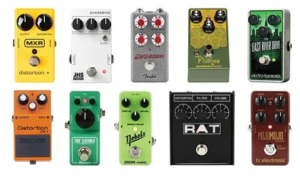
What should you look for in a distortion pedal?
When trying to choose the best distortion pedal for you, the first thing to consider is functionality. You’ll probably be looking for something with multiple gain stages, much like the channels on an amp.
In that case, you’ll have plenty of options for switching between the two gain sounds, and in some cases, even stacking them.
Maybe you’re looking for something simple? Well, a single-button distortion pedal is more than you can handle.
The next important factor is the general shape of the distortion.
No, not the actual shape of the device, but the sound of the distortion itself. If you prefer a more vintage tone, Bogner and Friedman are the right choices for you.
If you need a more modern sound, the Mesa/Boogie Throttle Box and Kirk Hammett’s signature Dark Blood offer some truly outstanding modern gain sounds.
Among our selections, you’ll find multichannel products, mixable drives, and amp-inspired circuits at a variety of price points.
Where should a distortion pedal be placed in the chain?
In most cases, it’s a good idea to place a distortion pedal early in the chain, typically stacked after an overdrive or boost pedal.
We often mention this, but there’s no rule about it. Many guitarists use a distortion pedal after a reverb, for example, to create a massive sound. Another classic use case is the Boss HM-2, which is placed in an effects loop to push the amp harder.
Which distortion pedal is best for metal?
Distortion pedals are generally used for heavy-style music, so it’s a common question to ask what pedals are best for metal. It really depends on the specific metal genre you’re talking about.
There are many styles of metal, and therefore many tones. So take a look at your favorite guitarist’s pedalboard and see what they use for inspiration.
The distortion pedals on this list can sound great for metal if you dial them in properly.
Many players think that you need to dyne every knob to get a great metal tone, but the truth is that turning it down a bit can really help with clarity and a ‘tighter’ sound, so be careful with the gain knob.
A classic trick for metal tone is to ‘scoop’ the midrange, and many pedals have this built right into their EQ sections, but again, be careful.
If you take too much of the midrange out, you can lose your tone, especially when playing with other guitarists in a full-band scenario.
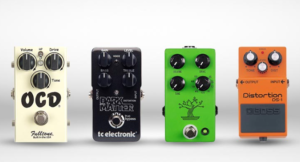
Who makes the best distortion pedal?
The best distortion pedal depends on the tone you’re trying to create. It’s very subjective. However, brands like Walrus Audio, Fender, MXR, Earthquaker Devices, JHS, Boss, and EHX all make great distortion pedals.
What are some good distortion pedals?
The Walrus Audio Iron Horse V2 is a great distortion pedal. It’s based on the classic RAT pedal but offers more flexibility and improved tones.
There’s also the Fender Pugilist Distortion, EQD Acapulco Gold, and Empress Effects Multidrive.
What’s the most versatile distortion pedal?
The Fender Pugilist is a very versatile distortion pedal thanks to its two gain stages and the ability to run them in series or blend them together. There’s a dual version of the pedal that offers even more flexibility.
The Empress Effects Multidrive is another versatile stompbox. This pedal combines distortion, fuzz, and overdrive pedals in one pedal.
You can switch between different combinations, and it has a variety of toggle switches, a 3-band EQ, and more.
Also read: Top 10 Best Fuzz Pedals

